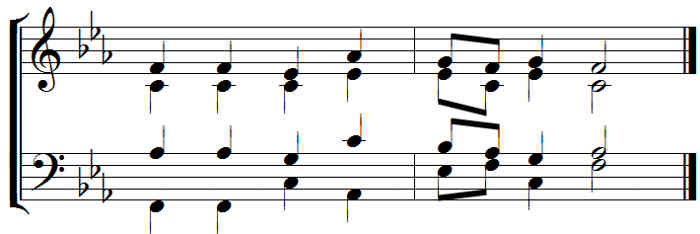THE CHOIR TRAINERS TOOLKIT
Background Reading
Modes
Older music (largely before 1600, but some after) is written in MODES. These were the precursors of our major/minor keys
and the key signature rules given on the Key Signatures page don't apply to them.
Originally, modal pieces were written without accidentals or key signatures but during a long period of transition, something like our modern system evolved.
Here is the conclusion of Nun komm, der Heiden Heiland, a German melody fron the 12th century, with a harmonisation from 1609.
 The key signature suggests Eb major or C minor, but the last bass note is F. (If you want to get technical, it's the Dorian mode, starting on F. [If you really want to know a lot about modes - go HERE. We don't want
to get tangled up in these pages.])
The key signature suggests Eb major or C minor, but the last bass note is F. (If you want to get technical, it's the Dorian mode, starting on F. [If you really want to know a lot about modes - go HERE. We don't want
to get tangled up in these pages.])
If a choir asks, you could say something like,"It's a sort of modal F minor," and hope that they are happy with that.
This is no problem if you want to transpose it. Just pretend that it's in Eb, follow the rules given earlier (in the Transpostion page) and you will end up with everything
perfectly in place.
Why might you want to transpose it? See HERE.
This is the conclusion of a piece of harmonised plainsong:
 The key signature suggests F major or D minor, but the last bass note is G. (It's in the hypodorian mode if you want to get technical.) Once again, this is not a problem. Assume an F major key signature,
transpose according to the rules, and all will be fine.
The key signature suggests F major or D minor, but the last bass note is G. (It's in the hypodorian mode if you want to get technical.) Once again, this is not a problem. Assume an F major key signature,
transpose according to the rules, and all will be fine.
RETURN TO:
TOP
MENU - Choir Trainer's Toolkit
MENU - Organists Online
More on Minor Key Signatures
If, when deciding whether a key signature is major or minor, you have lingering doubts,
there is an additional check. This check can be very useful if you only have a melody to look at without a bass note.
With a minor melody, it's not uncommon for the 7th note of the scale (the one just below the tonic or key note) to be raised a semitone by an accidental.
This snippet could be in Ab major or F minor:
 However, the 7th note of an F minor scale would be E, and the E is raised a semitone by a natural, so the key is F minor.
However, the 7th note of an F minor scale would be E, and the E is raised a semitone by a natural, so the key is F minor.
In this example, which could be in G major or E minor, the D (the 7th note of a scale starting on E) is sharpened, so the key is E minor.
 And one last possible check - if you have an unaccompanied melody, there's a good chance that the last note is the key note.
And one last possible check - if you have an unaccompanied melody, there's a good chance that the last note is the key note.
Some melodies are truly key-androgynous. For instance, the Passion Chorale (O sacred head, sore wounded) is harmonised by Bach both as a major melody and as a minor melody in different contexts.
RETURN TO:
TOP
MENU - Choir Trainer's Toolkit
MENU - Organists Online
Confusions?
At the end of Bach's A minor harmonisation mentioned above, the last bass note is an E - the fifth note of the scale. But then, as also mentioned above, this melody is major/minor androgynous.
Percy Buck's hymn tune Gonfalen Royal is in G major, but ends every verse with a D in the bass. However, there is a final Amen which resolves to a G major chord.
Martin Shaw's melody Little Cornard (Hills of the North, Rejoice) starts in C minor and ends in Eb major.
Similarly, Graham Kendrick's The Servant King starts in C minor and ends in Eb major.
However, cases such as these are exceptions. If you are having to transpose a piece, the general rules given elsewhere hold good, no matter how exceptional the melody may be.
RETURN TO:
TOP
MENU - Choir Trainer's Toolkit
MENU - Organists Online